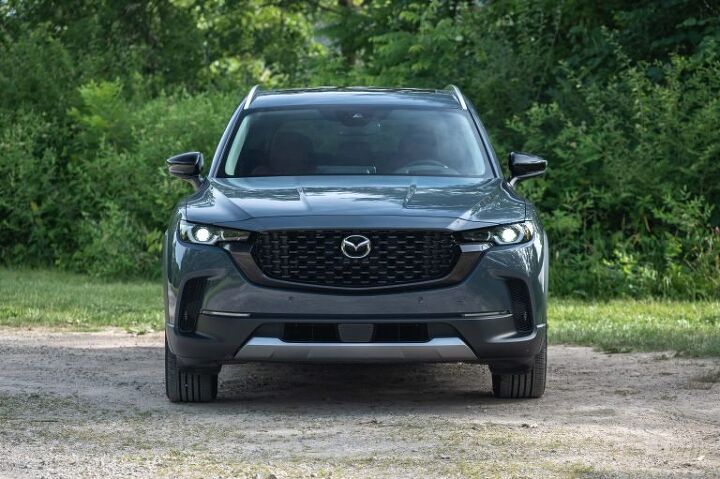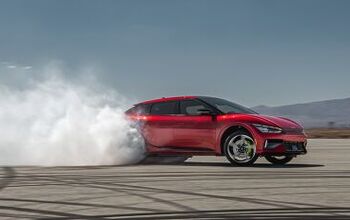2023 Mazda CX-50 Review – Playing Dress-Up

2022 Mazda CX-50 2.5 Turbo Premium Plus AWD
Americans have got a fever, and the only prescription is more crossovers. Virtually every automaker trying to do business in this country has some sort of lifted wagon – if not a handful. Large ones, small ones, performance ones, economy ones. No convertible crossovers anymore, thank goodness. They’re shoehorning a crossover into nearly every possible market segment.
Here, we have the 2023 Mazda CX-50, with a name very much like their popular CX-5. And it’s very close in size to said CX-5. Of the six distinct non-electric vehicles offered by Mazda, four are crossovers – but why did they bring us something so very clearly similar to something they’ve been selling well for many years without replacing it?
Oh, and don’t give Mazda any ideas about a Miata crossover, please.
Mazda says the CX-50 was developed – let me get the marketing language right here – “to support the active and outdoor lifestyles of customers…” Images accompanying the press release show the CX-50 in nature – on groomed trails and adjacent to trees. Yeah, I know my photos have the car posed on a gravel lot near a river, too.
As such, the CX-50 sports additional black plastic lower body cladding. The styling beyond the plastic is distinct, too – with a bit more ground clearance and a lower roofline than the CX-5 – making the entire car look longer. I won’t deny that it’s a handsome look, especially with the wheel wells filled up with the twenty-inch wheels fitted to this Premium Plus trim.
But I’m not sure it necessarily speaks to a rugged outdoor active lifestyle. Beyond the standard all-wheel drive and the selectable drive mode with an off-road mode, I don’t see a single thing on this car that makes it any more capable where the pavement ends than your typical crossover. No skid plates, no all-terrain tires, no locking differentials.
Will the CX-50 buyer care about this? I’m not sure that they will. Because once they get behind the wheel, they’ll find a comfortable, roomy, and above all luxurious family hauler. The ride quality is superb, with minimal wind and road noise and no harshness transmitted to the cabin from impacting expansion joints. The panoramic moonroof does bring nature in just a bit should you choose.
The turbocharged engine has plenty of power to get up to speed without drama, and while the six-speed automatic is down a few cogs from some competitors, it shifts smoothly and feels very well matched to both the engine and the nature of the CX-50. The driving experience is basically identical to that of the CX-5 – which is to say, pleasant.
Infotainment is getting better from Mazda, with a display that is clearer and more snappy to respond than in years past. But it’s still commanded by a central dial near the shifter, with a couple of buttons to toggle for music or nav. Wireless Android Auto and Apple CarPlay are welcome additions.
Let’s consider, then, what should be the best comparison in the entry-luxury compact crossover market – the Lexus NX. Tim took a look at the NX 350 last week. Dimensionally, both the NX and this CX-50 are quite close inside and out – the Mazda has a slightly longer wheelbase (110.8 inches versus 105.9 for the Lexus) within roughly the same length (185.5 inches for Mazda, 183.5 inches on the Lexus). Cargo space is a win for the Mazda as well – 31.4 cubic feet behind the rear seats, versus 22.7 cubes on the Lexus.
And yet picking the entry trim of the NX 250 and simply adding all-wheel drive will run $41,025 delivered – without a number of features (like heated/ventilated seats, the moonroof, and leather) the Mazda gives on this $43,170 Turbo Premium Plus package. Matching the two up shows the value here, and the quality of the materials and appointments within the Mazda (caveat for the infotainment here) are at least every bit the equal of the Lexus.
Mazda is a luxury brand now. This is not my father’s Mazda of the GLC era, lined as it was with repurposed mouse fur. I’m sure Toyota isn’t thrilled that they’re helping to build (at the Alabama joint venture facility) such a vehicle that might make cross-shop their own premium line, but that’s how great a job Mazda has done here.
To be fair, no amount of black plastic cladding can ever make this an off-roader – not with the snazzy twenty-inch wheels and low-profile tires fitted here. That’s ok – the slight nod toward off-road fashion is like that one nice pair of running shoes I once bought, thinking I might get off the couch and start running to lose some weight. Nope. They’ve been relegated to very comfy lawn-mowing sneakers – and at least until they turned green, they looked good doing so.
With the 2023 CX-50, Mazda is leaning in hard to court those who imagine themselves with an active and outdoor lifestyle. Whether it succeeds is a question yet to be answered.
[Images: © 2022 Chris Tonn]

Some enthusiasts say they were born with gasoline in their veins. Chris Tonn, on the other hand, had rust flakes in his eyes nearly since birth. Living in salty Ohio and being hopelessly addicted to vintage British and Japanese steel will do that to you. His work has appeared in eBay Motors, Hagerty, The Truth About Cars, Reader's Digest, AutoGuide, Family Handyman, and Jalopnik. He is a member of the Midwest Automotive Media Association, and he's currently looking for the safety glasses he just set down somewhere.
More by Chris Tonn
Latest Car Reviews
Read moreLatest Product Reviews
Read moreRecent Comments
- Wjtinfwb Nice car and looks well cared for. The accessories are mostly for vanity, their value is in the eye of the buyer. I see zero value in them but I like bone stock if buying used. The problem this seller has is his spec is not at all unique; not a manual, no Shaker hood, attractive, but conservative color. Today, AutoTrader has 130 used 2015-2018 Challenger Hemi's with automatics available. The average price is abut 27,200 and mileage is slightly lower than this example at about 40k miles. Almost all are at dealers where a decent negotiator should be able to knock $1500-2500 off the ask. This is a 25k car, the buyer may not believe it but stats would say otherwise.
- Turbo Is Black Magic Honestly at this point Elon is more of a liability than an asset. How much does the board have to pay to just get rid of him?
- FreedMike The article touches on this fact, but the number of public EV chargers grew by over 18,000 between 2021 and 2023. https://afdc.energy.gov/fuels/electricity-infrastructure-trendsSo clearly the expansion is happening without the use of the funds in question. Not necessarily a bad thing, if you're into not using taxpayer money. Still, I'd be interested in knowing why the public money isn't being used. Are the regs overly complex or restrictive, or something like that? But in any case, EV charging IS expanding at a pretty solid rate. And as far as "...we’ve seen plenty of Republican-backed legislation targeting EV-related spending over the last couple of years" is concerned...well, yeah, there's a reason why Republicans don't like EV charging. The petroleum industry is one of the GOP's prime donors, and every charger built or EV sold represents a direct ding to their bottom line. Republicans, of course, like to put this in terms of "EVs are a woke mind virus," or some such nonsense, but the fact is that the people paying their bills don't want competition.
- 28-Cars-Later When its discontinued.
- NigelShiftright If this boondoggle had worked, we'd have half a million charging stations with no generating capacity to speak of.









































Comments
Join the conversation
Ride quality may be related to the tires. Those 20" need a low-profile to fit. I suspect that the standard 17" tires provide a noticeably nicer ride. Too bad those cars are flogged to the reviewers by the Mazda PR people.
Hasn't anybody else noticed that the lowered roofline results in tiny side windows? They're only about one-and-a-half Big Gulps tall. When I'm out having motoring adventures in outdoorsy settings, I like to be able to see the scenery.